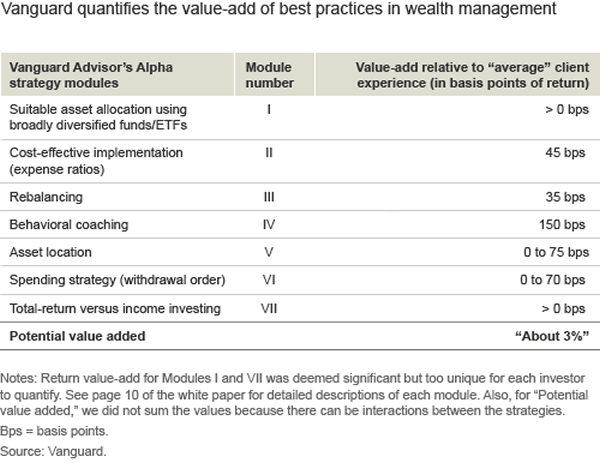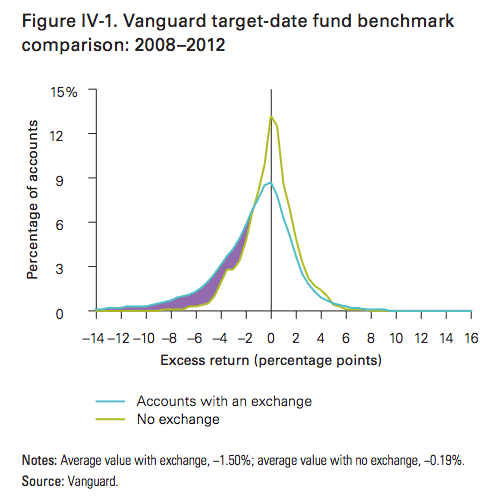Vanguard has released a research paper called Putting a value on your value: Quantifying Vanguard Advisor’s Alpha, which provides the data and methodology behind its previous statement that a good financial advisor should be able to affect the performance of client’s portfolio by about three percentage points. The areas where good management can add value are summarized in the graphic below:

As a DIY investor, this chart also provides suggestions for areas to focus your energy. The biggest single “value-add” appears to be in the area of behavioral coaching. This basically boils down to convincing the client/investor not to abandon their previous plans during times of extreme greed (bull market) or fear (bear market). In other words, do nothing. In my previous post, I posed that a simple Vanguard Target Date Retirement fund would provide both low expense ratios and regular rebalancing – no advisor required. It turns out that if you can buy one of these Target funds and leave it alone for a long time, you’ll do even better…
Vanguard analyzed the performance of 58,168 self-directed Vanguard IRA investors from 1/1/2008 to 12/31/2012, a 5-year period which includes both the financial crisis and subsequent recovery. These self-directed investors were compared with an appropriate Target Date fund benchmark. The authors even state “For the purpose of our example, we are assuming that Vanguard target-date funds provide some of the structure and guidance that an advisor might have provided.”
An investor who made at least one buy/sell exchange between funds over the entire five-year period trailed the applicable Vanguard target-date fund benchmark by 1.5% annually on average. Investors who made no exchange lagged the benchmark by only 0.19%. The chart supplied is a little tricky to read, but illustrates the performance gap.

(You want more “area under the curve” on the positive excess return side, and less “area under the curve” on the negative excess return side.)
I agree a good financial advisor can add value. Many people are doing none of the strategies listed above. However, a motivated DIY investor can implement most of not all of these strategies themselves. If you can buy a Vanguard Target Retirement fund and leave it alone (easier said than done), you can get much of the way there without an advisor. The problem is that you may have to go through an extreme market cycle to know if you can actually do it. Excerpted from the paper’s conclusion:
This 3% increase in potential net returns should not be viewed as an annual value-add, but is likely to be intermittent, as some of the most significant opportunities to add value occur during periods of market duress or euphoria when clients are tempted to abandon their well-thought-out investment plan.
 The Best Credit Card Bonus Offers – March 2024
The Best Credit Card Bonus Offers – March 2024 Big List of Free Stocks from Brokerage Apps
Big List of Free Stocks from Brokerage Apps Best Interest Rates on Cash - March 2024
Best Interest Rates on Cash - March 2024 Free Credit Scores x 3 + Free Credit Monitoring
Free Credit Scores x 3 + Free Credit Monitoring Best No Fee 0% APR Balance Transfer Offers
Best No Fee 0% APR Balance Transfer Offers Little-Known Cellular Data Plans That Can Save Big Money
Little-Known Cellular Data Plans That Can Save Big Money How To Haggle Your Cable or Direct TV Bill
How To Haggle Your Cable or Direct TV Bill Big List of Free Consumer Data Reports (Credit, Rent, Work)
Big List of Free Consumer Data Reports (Credit, Rent, Work)
why would you rebalance more than annually with a $ 100,000 portfolio
Ed, what is it about 12 month periods that you believe make that the optimal rebalancing period for a 100K portfolio?
Based on that, what would you see as the optimal rebalancing period for a 1M portfolio?
Sometimes I wonder if it would be better of in a LifeSTrategy or Target Date fund to prevent myself from analysis paralysis…
I’m in two minds when it comes to reshuffling my portfolio on a yearly basis. I generally don’t go for any retirement funds. I buy stocks on a regular basis. Before I say anything more, let me tell that my portfolio includes all kinds of stocks across the industries. So, at the end of the year the rise and fall of some stocks get neutralized and the performance has been anything between 15 to 20%. I’ve been doing this for the last five years. Except for the first year my return on investment has never been less than 15%. Please also note that I don’t buy index funds and I don’ invest in future or options too. Still I get this return. In fact, after doing DIY for the last few years the knowledge I gained is that reshuffling of stocks is very necessary if you want to get a steady growth in the portfolio. I generally base my decisions upon fundamental aspect of a stock, backed up by the technical readings, which I get from my trading platform and other sources. I generally don’t reshuffle every month or even every quarter, until and unless performance of the stock is too poor. I generally keep out those stocks out of my basket that give negative returns on a yearly basis. That kind of DIY helped me a lot and I hope helps other too.
I like the expense ratios of Vanguard target funds, but I’m a little concerned about their weighting in stocks. Do these funds also invest in real estate or commodities to balance their exposure. If not, why not. Wouldn’t those be components of a diversified strategy? Looking back at 2008, it seemed like target funds got hammered more than a truly diversified portfolio did. I recall Jonathan referencing an article by Burton Malkiel, which exemplified that.
@Martha, it’s good to hear you’re having such success with a self-managed portfolio of diverse stocks. 15-20% annually is indeed a very impressive return. I would caution you against feeling like too much of an investment genius just yet though, if this report is based solely on experience over the last 5 years, as you suggest. If you look at overall market returns in the post-2008 era, an average of 15-20% seems fairly typical. If you’d simply bought an S&P 500 index fund 5 years ago, for instance, you could sell it right now for a 212% return (>20% annual increase), and the years in between generally appear to have born that trend with reasonable consistency. Based on all past data since pretty much the existence of markets, at some point these sorts of returns will no longer be the norm, and the market will at least taper downward some (if not plunge) as we enter the second part of the “boom/bust” cycle. At this point, I strongly suspect that whatever stocks you end up picking will also end up yielding net negative returns. I don’t mean to be a wet blanket, and hope you’ll continue to research and invest for the rest of your life. Just be aware that unless you’re the next Warren Buffet, you may not always be able to achieve the sorts of returns you’ve seen during this most recent growth period, and it’s good to realize that market investing can be volatile. Diversification and rebalancing are often brought up as ways to help mitigate the negative effects and exploit the positive effects of this volatility, over the long term.